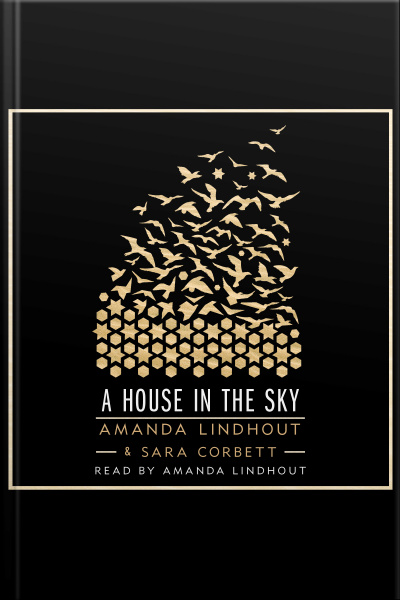A House In The Sky: A Memoir
- Author: Amanda Lindhout
- Narrator: Amanda Lindhout
- Publisher: Simon & Schuster
- Duration: 13:16:44
Synopsis
This reading group guide for A House in the Sky includes an introduction, discussion questions, and ideas for enhancing your book club. The suggested questions are intended to help your reading group find new and interesting angles and topics for your discussion. We hope that these ideas will enrich your conversation and increase your enjoyment of the book.
Introduction
As a child, Amanda Lindhout escaped a house governed by chaos and violence by paging through old issues of National Geographic and imagining herself in its exotic locales. At the age of twenty, Amanda boarded her first international flight to see those places in person. She traveled through Latin America, then Laos, then Bangladesh and India. When money ran out, she returned home to work and save for the next adventure, launching herself deeper into the world each time—backpacking solo across Sudan, Syria, Pakistan—and closer to some sort of edge, while also beginning to carve out a career as a reporter. In August 2008, she traveled to Mogadishu, Somalia to report on the fighting there. Three days into her visit, she and her friend, a photojournalist, were abducted. What follows is the story of Lindhout’s fifteen months in captivity. While her family in Canada attempts to negotiate impossible ransom demands, Lindhout focuses on staying alive—converting to Islam, receiving “wife lessons” from a militia leader, and plotting a risky escape that has devastating consequences. As the abuse she suffers escalates, A House in the Sky becomes a testament to the capacity of the human spirit to overcome unspeakable adversity and find a deeper resolve to live.
Topics & Questions for Discussion
1. Above all else, Amanda identifies herself as a traveler, an identity born out of her childhood obsession with National Geographic. Why do you think National Geographic had such a large impact on her? What led Amanda to make the leap from the legions of armchair travelers into someone whose life revolved around her journeys?
2. On page 14, Amanda discusses sneaking into an amusement park after dark, with a childhood friend. She writes, “…we allowed ourselves to relax and feel giddy, forgetting that it was dark and we were trespassing, forgetting everything that scared or haunted us…” How does this childhood memory reflect Amanda’s experience traveling to foreign countries and unknown places? Is part of the thrill of travel related to risk?
3. Amanda’s first trip, to South America, initially disappoints her because Caracas doesn’t “feel foreign”. What does this demonstrate about the different ways people travel? As she leaves Caracas and ventures into the kind of journey she’ll come to crave, what changes for her?
4. During this trip to South America, Amanda confronts the experience of venturing off the beaten path, and defines the feeling of the frontier as “a knifepoint between elation and terror” (p. 36). How will this balance come to define her travels?
5. The memory of cutting her friend Kelly’s hair will become one of the things that sustains Amanda throughout her captivity. Why do you think this memory sticks with her?
6. In Dhaka, Amanda experiences what she sees as the “beautiful” side of Islam, but also confronts the dangers inherent in being a solo female traveler in that particular place. How does this dichotomy influence her experiences in captivity?
7. On page 67, Amanda quotes Paul Theroux’s Dark Star Safari, “All news out of Africa is bad. It made me want to go there…” Both Nigel and Amanda understand this sentiment, and it’s partially what draws them to Somalia. What do you make of the idea that bad news would bring someone to a place?
8. Amanda’s time in captivity is spent trying to negotiate the best way to stay alive—she vacillates between trying to understand and connect with her captors, through things like converting to Islam, and resistance like trying to escape. Why do you think Amanda and Nigel have such different takes how to best manage their captivity? What do you think are some of the advantages and disadvantages of each method?
9. When Amanda overhears a report of their capture on the radio, she writes of the feeling as “crushing. It was confirmation that our troubles were both real and deep” (p. 146). Why do you think this affects her so powerfully?
10. When Amanda is given an English-language Koran, it is the beginning of her “conversion” to Islam. How does Amanda’s relationship with Islam change throughout her time in captivity? As she reads the Koran and begins to understand it, and thus her captors, better, how does her awareness of her situation change?
11. Amanda reflects throughout the book on the strangeness of the relationships with her captors—even though they were imprisoning her, she attempted to feel compassion and understanding for them. Were you surprised that this was possible? Discuss Amanda’s relationships with Jamal, Ali, Adam, and the rest.
12. Nigel and Amanda’s relationship as fellow captives is at times extremely difficult. Discuss their different ways of coping. How did you feel when Nigel told Amanda to “just take this one”? Did you blame Nigel?
13. Throughout the book, and in particular during her captivity, Amanda uses mantras to calm herself. What does she find so effective about repeating simple words and phrases? Why do you think this kind of practice can be soothing?
14. On pages 220-221, Amanda writes about what being alone does to her mind, and refers to a kind of psychic energy that seemed insane before her captivity, but became more believable. What did you make of her account in your reading? Have you ever experienced this kind of psychic energy?
15. Discuss Amanda’s “house in the sky” (p. 292). How does this dream help her maintain hope, and survive?
16. Of writing notes to Nigel, Amanda says “…writing helped me to believe it. It staked some claim on the truth (p. 226)”. How does this idea relate to Amanda’s decision to write a book about her experience? How does Amanda’s relationship with writing evolve over her time in captivity (see also p. 364)?
17. How did reading A House in the Sky change your understanding of the role fundamentalist religion can play in a war-torn society? How did it change your perception of Somalia? What surprised you most in your reading?
Enhance Your Book Club
1. Since her release, Amanda has dedicated herself to humanitarian efforts, including some that have brought her to Africa, and back to Somalia. Visit her website: AmandaLindhout.com and learn about the Global Enrichment Foundation [http://www.globalenrichmentfoundation.org/]. How does the knowledge of Amanda’s work after her captivity alter your understanding of the book?
2. Amanda is active on social media. Connect with her on:
Facebook (https://www.facebook.com/AmandaLindhoutPage)
Twitter (https://twitter.com/AmandaLindhout)
YouTube, (http://www.youtube.com/user/globalenrichment)
Instagram (http://instagram.com/amandalindhout#)
Twitter (https://twitter.com/AmandaLindhout)
Chapters
-
AHouseInTheSky 21 Chapter19
Duration: 18min -
AHouseInTheSky 22 Chapter20
Duration: 21min -
AHouseInTheSky 23 Chapter21
Duration: 20min -
AHouseInTheSky 24 Chapter22
Duration: 28min -
AHouseInTheSky 25 Chapter23
Duration: 20min -
AHouseInTheSky 26 Chapter24
Duration: 10min -
AHouseInTheSky 27 Chapter25
Duration: 20min -
AHouseInTheSky 28 Chapter26
Duration: 18min -
AHouseInTheSky 29 Chapter27
Duration: 17min -
AHouseInTheSky 30 Chapter28
Duration: 31s -
AHouseInTheSky 31 Chapter29
Duration: 19min -
AHouseInTheSky 32 Chapter30
Duration: 27min -
AHouseInTheSky 33 Chapter31
Duration: 23min -
AHouseInTheSky 34 Chapter32
Duration: 15min -
AHouseInTheSky 35 Chapter33
Duration: 14min -
AHouseInTheSky 36 Chapter34
Duration: 14min -
AHouseInTheSky 37 Chapter35
Duration: 17min -
AHouseInTheSky 38 Chapter36
Duration: 19min -
AHouseInTheSky 39 Chapter37
Duration: 06min -
AHouseInTheSky 40 Chapter38
Duration: 09min









